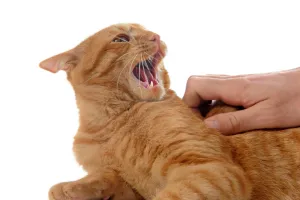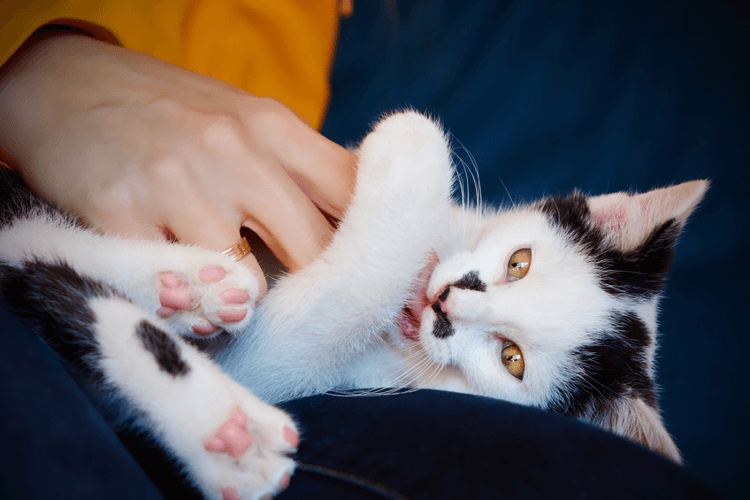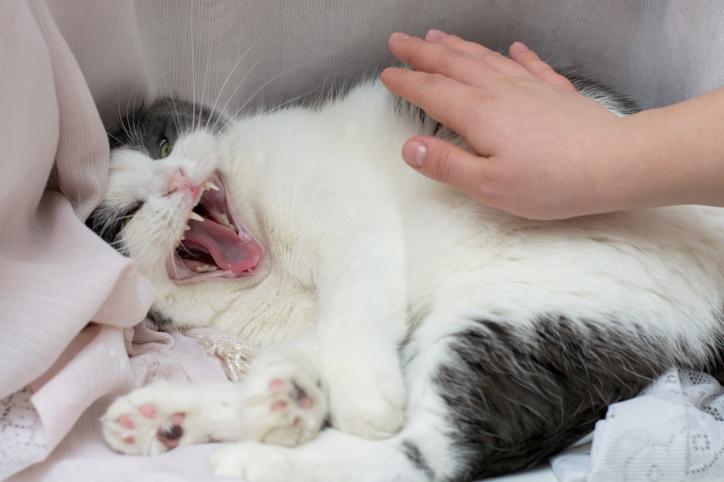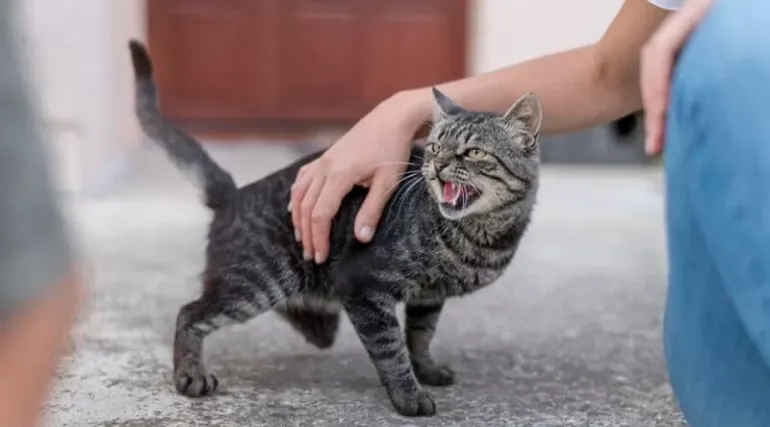Cat aggression toward human
Overview
- Behavior that is intolerable toward people.
- Can be directed at family members or people you don't know.
- Cats can do a lot of damage with their claws and teeth, so don't forget how mean they can be to people.
- Young children and older people with thin skin are most likely to get hurt.
- Cause: different.
- The signs can range from hissing and biting to hurting someone physically.
- Treatment: changes based on the reason.
Reasons for Cat Aggression Toward Humans
Additionally, as was already said, it's not unusual for cats to act mean toward people. This behavior isn't caused by the same things that make them mean to other animals or pets, but it's still important to know about them.
Here are five common reasons why cats attack people:
- Keeping their kittens safe. Mother cats protect their kittens very well. Human family members may want to stay away from a mother cat with new kittens as much as possible if you have one in your home. If someone comes up to her, especially if they are trying to pet her kittens, she might get very mean.
- Pain or sickness. If your cat is in pain, it may become angry and defensive. The same goes for a cat that is really sick. Take your cat to the vet right away if they are acting mean and show signs of being in pain or sick. They will deserve the best care and treatment.
- Too Much Stimulation. If your cat has too much to do, it might get angry and hurt someone. A cat is often overstimulated when it is petted for too long. Other things that can cause this are too much play, too much noise, or too much contact with family members.
- Changes in Anger. Cats can become aggressive when they take their anger out on something else. Cats may take out their rage and anger on people in the family as a way to avoid dealing with the real problem. For instance, if your cat sees another cat outside the window and you go to pick them up, they might get angry and lash out at you with their claws.
- New Child. Your cat's whole world will quickly turn upside down if you bring home a kid. This can sometimes make cats act aggressively when they are normally pretty calm and tame. Of course, your cat might be mean to the baby, but she's more likely to be mean to the adults in the family who are still playing with the baby.
Presenting signs
- Hostility towards humans ranging from hissing, spitting and growling to inflicting physical injury.
- The aggression may be defensive or offensive and differentiation between the two may be difficult.
- Aggression toward people may be generalized or may be victim or context specific.
- The specific presentation will vary with the etiology.
Petting and biting syndrome
- Aggression will be associated with petting and the threshold for displays of aggression will vary considerably between cases, the cat will tolerate a certain amount of handling and then suddenly bite and claw the owner.
Misdirected predation
- Aggression will be triggered by movement - typically owners are attacked on the legs, hands and arms.
Frustration-related aggression
- Become aggressive to owners when their demands are not me
Fear-related aggression
- This form of aggression is displayed when the cat is challenged or feels threatened - it may be associated with handling but not exclusively.
Redirected aggression
- Aggression is directed toward people who are nearby although the actual motivation for the aggression is unrelated to the human, eg when seeing another cat in the garden when they are restricted in the house, they may turn their aggression on people.
Special risks
- Risk of cat scratch fever (Cat scratch disease) should always be explained to owners of aggressive cats.
Pathogenesis
Etiology
- The aggression is often a natural defense reaction which is inappropriate either in its intensity or its context.
- Fear is often implicated and may stem from lack of appropriate socialization and habituation as well as from specific traumatic experiences.
- There is often a learned component to the behavior.
- The aggression is the result of a number of interacting factors including the genotype, phenotype, neurophysiology and hormonal status of the cat and factors from the environment.
Petting and biting syndrome
- The aggression in these cases is believed to be linked to a conflict between adult characteristics and perpetuated juvenile characteristics.
Misdirected predation
- Lack of opportunity to engage in normal feline behavior. This sort of aggression can also occur as a result of inappropriate learning where kittens are encouraged to play with peoples' hands and feet.
Frustration-related aggression
- Often associated with hand rearing where kittens do not learn to cope with frustration.
Fear-related aggression
- Very common in cats who have not been socialized and habituated adequately before seven weeks of age.
Redirected aggression
- The aggression may have a variety of etiologies unrelated to the person who attacked - the person is simply an available target.
Predisposing factors
Petting and biting syndrome
- Lack of appropriate types of handling from 2-7 weeks of age. Kittens need to learn to tolerate restraint and close handling.
Misdirected predation
- Lack of opportunity to engage in normal feline behavior. Inappropriate play with peoples' hands and feet.
Frustration-related aggression
- Hand rearing.
Fear-related aggression
- Lack of socialization and habituation from 2-7 weeks of age, previous traumatic experiences involving people, lack of opportunity to escape from threatening situations.
Redirected aggression
- Lack of access to the original trigger for the aggressive response.
Diagnosis
- Aggressive behavioral response to people which may be generalized or context or victim specific.
- Aggression may be offensive or defensive in nature.
Client history
- Aggressive behavioral response to people which may be generalized or context or victim specific.
Petting and biting syndrome
- Aggression toward people, usually owners, when they are petting and cuddling the cat. Owners report that the cat appears to be enjoying being held and then suddenly attacks with teeth and claws.
Misdirected predation
- Aggression consisting of ambush attacks on peoples' hands, feet, arms or legs.
Frustration-related aggression
- Aggression toward people associated with incidents where the cat is thwarted in some way. In the majority of cases the cat has been hand reared on a feed on demand basis.
Fear-related aggression
- This sort of aggression is often context and/or victim specific if it has resulted from a traumatic experience, more generalized fear aggression will result from lack of socialization and habituation. The history will include fearful body posture and other fear related behaviors It is most commonly seen when the cat is confined or restrained.
Redirected aggression
- History of unexpected attacks on people often when the cat is focused on another source of stimulation for example watching another cat outside.
Clinical signs
- Aggressive behavioral response to people which may be generalized or context or victim specific.
- Aggression may be offensive or defensive in nature.
Other similar cases
- Other forms of aggression.
- Medical conditions causing aggression, eg pain
- Hyperthyroidism.
Initial symptomatic treatment
- Avoid confrontation.
- Minimize potential physical injury.
- Avoid all physical punishment and unintentional reinforcement of the aggression.
- Allow the cat freedom to escape from challenging or potentially threatening situations.
Standard treatment
- Behavioral therapy which is based on the causal motivation and is tailor made according to the specific circumstances of each individual case.
- It is essential that diagnosis is accurate if treatment is to be successful.
Petting and biting syndrome
- Increase threshold of tolerance for close handling.
Misdirected predation
- Redirect predatory behavior onto suitable targets, preferrably by allowing cat access to outdoors but also through provision of suitable play, discourage misdirected predation by removal of unintentional reward.
Frustration-related aggression
- Increase ability to deal with frustration by initiating behavioral weaning.
Fear-related aggression
- Use desensitization and counterconditioning techniques, use controlled introductions to people and work to form positive associations with interactions with people.
Redirected aggression
- Use behavioral therapy to deal with causal motivation for the aggression.
- Selective use of psychopharmacology - only effective in combination with behavioral modification - the drug must be selected according to causal motivation for the behavior, eg fear, and owners must be aware that drugs in this context are not usually licensed for use.
Prevention
Petting and biting syndrome
- Adequate and appropriate socialization and habituation including introduction to restraint and close handling, encourage juvenile behaviors, cease physical interaction before cat reaches its tolerance threshold.
Misdirected predation
- Provide adequate opportunity for cat to display normal predatory behavior either through access to outdoors or through appropriate play, do not allow kittens to play predatory games with human hands and feet.
Frustration-related aggression
- When hand rearing kittens ensure that they go through behavioral and nutritional aspects of the weaning process.
Fear-related aggression
- Ensure adequate socialization and habituation.
Expected response to treatment
- Alteration in behavioral signs.
Reasons for treatment failure
- Not a correct diagnosis.
- Owner not following through.
- Not being able to control the things that make people angry.










